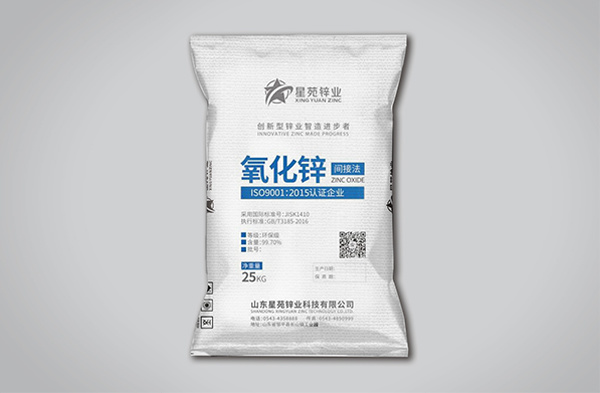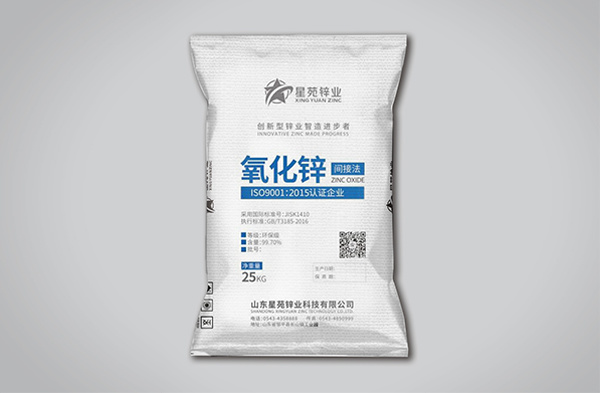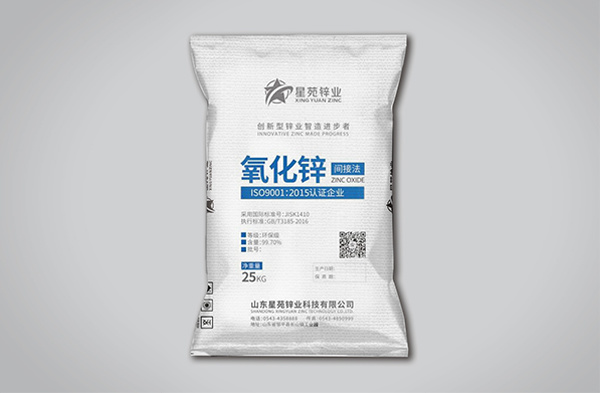CONTACT US
Email:
xingyuanchem@163.com
Telephone:
+86-543-4358888
Address:
Houhuai Village, Changshan Town, Zouping County, Binzhou City, Shandong Province
Zinc oxide | Indirect process zinc oxide
Categories:
Keywords:
Zinc oxide | Indirect process zinc oxide
Product Introduction
Physicochemical Properties of Zinc Oxide White hexagonal crystalline or powder. Tasteless, non-toxic, fine texture. Relative density 5.606. Refractive index 2.008-2.029. Melting point 1975℃. Soluble in acid, sodium hydroxide, and ammonium chloride; insoluble in water, ethanol, and ammonia. It is an amphoteric oxide. It absorbs carbon dioxide and water in the air to form zinc carbonate, appearing yellow. It turns yellow when heated and recovers its white color after cooling. It does not transmit ultraviolet light and does not turn black when exposed to hydrogen sulfide.
Uses of Zinc Oxide Used as a white pigment in printing and dyeing, papermaking, matches, and the pharmaceutical industry. In the rubber industry, it is used as a vulcanization activator, reinforcing agent, and colorant for natural rubber, synthetic rubber, and latex. It is also used in the production of zinc chromate yellow, zinc acetate, zinc carbonate, zinc chloride, etc. In addition, it is used in the manufacturing of electronic laser materials, phosphors, feed additives, catalysts, and magnetic materials.
Zinc Oxide Production Method Indirect method: Zinc ingots are heated to 1000℃, melted and vaporized, and then oxidized by introducing hot air to produce zinc oxide. After cooling and cyclone separation, the fine particles are collected using a bag filter to obtain the finished zinc oxide product.
Zinc Oxide Uses of:
1. Zinc oxide is mainly used in the rubber or cable industry as a reinforcing agent and activator, as a colorant and filler for white glue, and as a vulcanizing agent for chloroprene rubber.
2. Used for desulfurization of raw gas in the fertilizer industry.
3. Zinc oxide is used as a white pigment, rubber vulcanization activator, organic synthesis catalyst, desulfurizing agent, and in electrophotography and pharmaceuticals.
4. Used for desulfurization of raw materials in ammonia synthesis, petroleum, and natural gas chemical industries.
5. Zinc Oxide Used as an analytical reagent, reference reagent, and matrix for fluorescent and photosensitive materials.
6. Used in electrostatic wet copying, dry transfer printing, laser facsimile communication, electrostatic recording of electronic computers, and electrostatic plate-making documents.
7. Zinc oxide is used in the plastics industry, sunscreen cosmetics, special ceramic products, special functional coatings, and textile hygiene processing.
8. Widely used in the deep desulfurization and purification processes of raw materials for ammonia synthesis, methanol, hydrogen production, and petroleum.
9. Zinc oxide is used as an astringent in the manufacture of ointments or plasters.
10. Used as a white pigment in printing and dyeing, papermaking, matches, and the pharmaceutical industry. In the rubber industry, it is used as a vulcanization activator, reinforcing agent, and colorant for natural rubber, synthetic rubber, and latex. Zinc oxide is also used in the production of zinc chromate yellow, zinc acetate, zinc carbonate, zinc chloride, etc. In addition, it is used in the manufacturing of electronic laser materials, phosphors, feed additives, catalysts, and magnetic materials. Used as a zinc supplement in feed processing.
11. Inorganic white pigment. Its coloring strength is inferior to titanium dioxide and lithopone. Zinc oxide is widely used in ABS resin, polystyrene, epoxy resin, phenolic resin, amino resin, and polyvinyl chloride, as well as in the coloring of paints and inks. In addition, it can be used in the rubber industry as a vulcanization activator, reinforcing agent, and colorant for rubber. It is also used in the production of oilcloth, cosmetics, enamel, paper, leather, matches, cables, etc. It can also be used in printing and dyeing, glass industry, pharmaceutical industry, etc. It is also used as a desulfurizing agent in ammonia synthesis. It is also used in the manufacturing of electronic laser materials, phosphors, feed additives, and magnetic materials.
12. Nutritional supplement (zinc fortifier).
13. Zinc oxide is a nutritional supplement for feed.
14. Zinc oxide is used as a reinforcing agent for rubber or cables, giving the rubber good corrosion resistance, tear resistance, and elasticity. It can also be used as a vulcanization activator for natural rubber, a colorant and filler for white rubber, and a vulcanizing agent for chloroprene rubber. Smaller particles (diameter about 0.1μm) can be used as light stabilizers for plastics such as polyolefins or polyvinyl chloride.
|
Product Name |
Zinc Oxide |
Sample |
Warehouse 0.00T |
|
Item |
Standard |
||
|
Superior Grade |
First Grade |
Qualified Product |
|
|
Color |
White |
||
|
Zinc Oxide (dry basis)% |
99.73 |
||
|
Metal as Zn |
None |
||
|
Lead Oxide (Pb) |
0.026 |
||
|
Manganese Oxide as Mn |
0.0001 |
||
|
Copper Oxide as Cu |
0.0002 |
||
|
Insoluble in Hydrochloric Acid % |
0.004 |
||
|
Ignition Loss |
0.13 |
||
|
Residue on Sieve (325 mesh) |
None |
||
|
Water Soluble % |
/ |
||
|
Volatile Matter at 105℃ % |
/ |
||
|
Oil Absorption, % |
/ |
||
|
Tinting Strength |
/ |
||
Online Consultation













